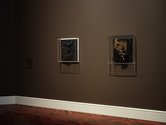John Hurrell – 17 July, 2024
In this Gus Fisher presentation, there are three types of exhibit: a selection of Jarman's feature films screened at the Capitol Cinema; two rooms of his large and small oil paintings; and one room of contextual photographic documentation-mostly of his low-lying garden and small cottage in Dungeness, Kent. In the support material, the wide range of his interests becomes apparent, ranging from poetry and script-writing to gay rights and anti-nuclear political activism.
Auckland
Derek Jarman
Delphinium Days
Curated by Lisa Beauchamp, Aaron Lister and Michael Lett
15 June - 14 September 2024
In a time of still Covid-influenced isolation and limited funding, when exhibitions in this country hardly ever feature overseas artists instead of NZ group or solo artist shows, this Derek Jarman display is a shining beacon. Of course, it fits in with the current global zeitgeist of diverse identity politics and bonding community themes—in this case countering discrimination against homosexuals—but current historic trends aside, it is quite an event to have a show that celebrates this charismatic English artist’s films, paintings and garden. Even though, as he often pointed out, many other talented individuals also contributed to their making.
In this Gus Fisher presentation, there are three types of exhibit: a selection of Jarman’s feature films screened at the Capitol Cinema or some Super 8 films on loops on monitors; two rooms of his large and small oil paintings; and one room of contextual photographic documentation—mostly of his low-lying garden and small cottage in Dungeness, Kent—taken by close friends like Howard Sooley and Gordon Rainsford. In the support material, the wide range of his interests becomes apparent, ranging from poetry and script-writing to gay rights and anti-nuclear political activism.
I was familiar with some of his films before this show, being a big admirer of Wittgenstein (1993) and Blue (1993), and I greatly enjoyed Caravaggio (1986) last month. If you know somebody with a DVD of Wittgenstein, I recommend seeing the extra features showing Jarman behind the scenes, directing the actors. He was a very gifted and charming communicator.
Jarman’s paintings greatly surprised me in Auckland as they often look corny in reproduction with their garish colour combinations and offhand Pollockesque flickering lines of paint. The salient value of the Gus Fisher show lies in the presentation of the (hard to photograph) darkly-beautiful grey-coloured, turbulent muddy paint of the small impasto assemblage works (incorporating smashed mirrors, chopped up text and male dolls). These are a striking contrast to the gorgeously sumptuous saturated colour of costumes in films like Wittgenstein.
Most of the paintings incorporate language (often sardonic) in some form and sometimes include autobiographical material involving his father Lancelot—an RAF pilot who originally came from Christchurch, NZ—while the three bigger works seem to allude chromatically to the flowers in his Dungeness garden, and verbally to AIDS and his subsequent dreadful demise.
These large last 1993 works use very short phrases: Arse Injected Death Syndrome; Blind Maniac; and Drop Dead. They were painted by assistants under his instructions as he was going blind—you could argue a form of conceptual art vaguely akin to related ‘blindfold’ smearing works by Robert Morris, but who used his own hands. With their frenetic squiggly textures of zigzagging agitated paint they are not overly sophisticated, but their large scale and terse text draws you in.
For me though, the smaller grey paintings are the stars of this show, with their very personal attached objects. They are spellbinding.
John Hurrell











 Two Rooms presents a program of residencies and projects
Two Rooms presents a program of residencies and projects Advertising in this column
Advertising in this column



This Discussion has 0 comments.
Comment
Participate
Register to Participate.
Sign in
Sign in to an existing account.